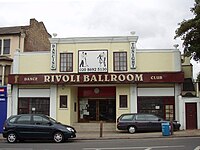Rivoli Ballroom

Exterior of Rivoli Ballroom
|
|
| Former names | Crofton Park Picture Palace |
|---|---|
| Address | 350 Brockley Road |
| Location | Crofton Park, London |
| Owner | Bill Mannix |
| Type | Dance hall |
| Genre(s) | Art Deco |
| Capacity | 700 |
| Construction | |
| Opened | 12 July 1913 |
| Renovated | 1957–1959 |
| Expanded | 26 December 1959 |
| Website | |
| Official website | |
Coordinates: 51°27′18″N 0°02′13″W / 51.4550°N 0.037°W
The Rivoli Ballroom is the only intact 1950s ballroom remaining in London, England. It is famed for its original decor and interior fittings (red velvet, flock wallpaper, chandeliers, glitter balls and oversized Chinese lanterns) and is often used as a film location and plays host to many dance and musical events.
The current building was originally the Crofton Park Picture Palace which opened in July 1913. It was designed by Henley Attwater with a simple barrel-vaulted auditorium. It became The Rivola Cinema in 1929.
The last film there was shown on 2 March 1957 after which the building was converted to a dance hall by local businessman Leonard Tomlin. It reopened as The Rivoli on Boxing Day, 1959 with a large Canadian sprung maple dance floor. Further improvements were made with the addition of a Member's Bar in 1960. It is currently owned by Bill Mannix.
The Brockley Road frontage is based on an Art Deco elevation which dates from 1931. A broad flight of steps passes into a deep-recessed central foyer. Pilasters, topped with plasterwork urns, terminate the elevation and the frontage currently features two signs reading 'Dancing' and 'Tonight'.
The ballroom comprises an eclectic mix of neo-classical, Deco and oriental motifs set within an exotic and luxuriant decorative scheme mainly dating from the 1950s. The main auditorium ceiling survives from the earlier cinema. From the off-street entrance steps a small foyer is reached featuring a raked floor and Deco-style marquetry panelling. The main motif is a geometric composition of intersecting curves in a shape with broad segmental top, tapering centre and curved base. The design is accentuated through the use of dark wood inlay and a diamond shape in the centre is picked out in glass or mirror. Although 1920s in inspiration, it is characteristic of the 1950s fashion for reviving the Deco aesthetic that had been unwillingly abandoned with the onset of WWII.
...
Wikipedia
